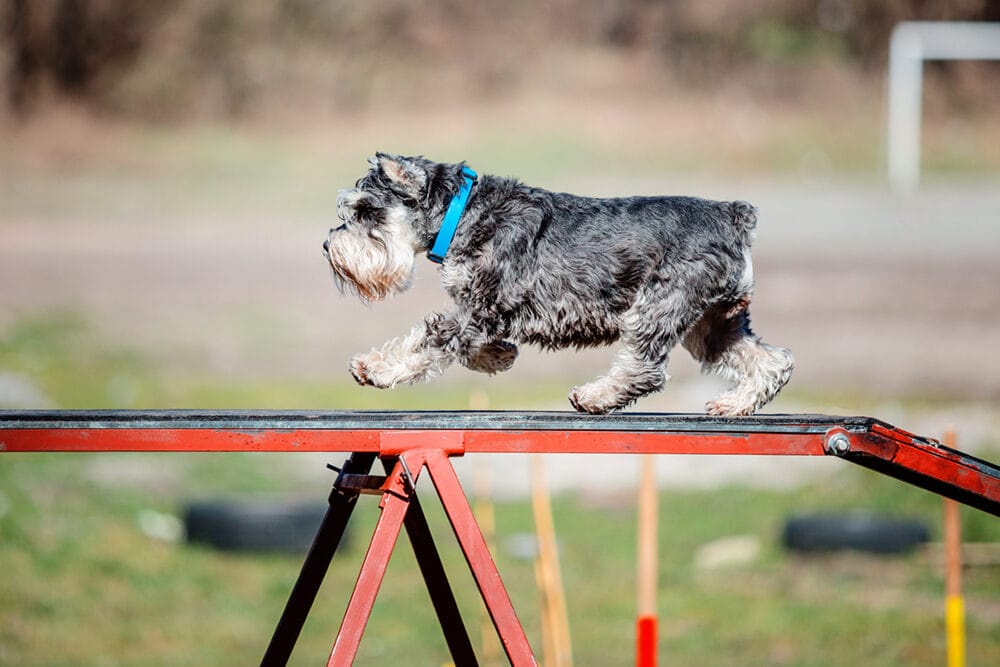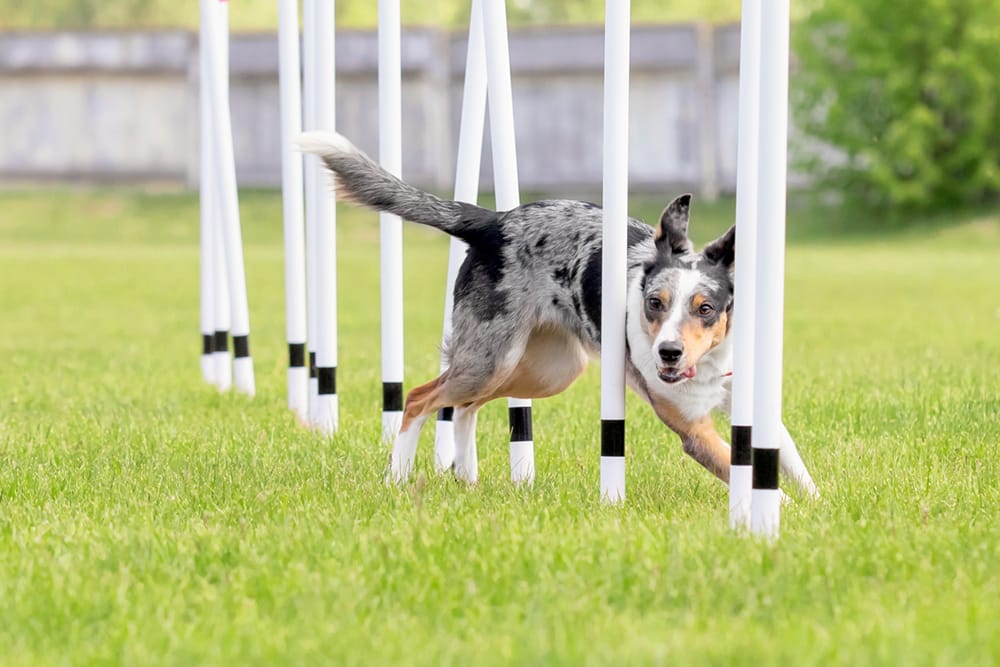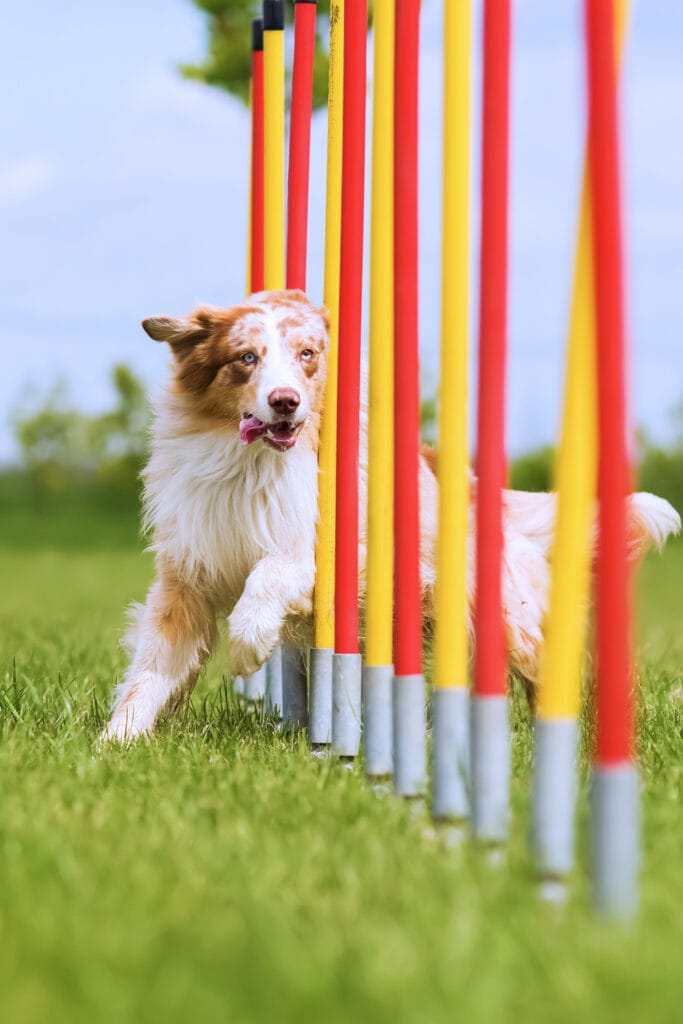Trainee Agility Judge Dominique Rossouw explains this energetic canine sport
Text: Rhiannon Cecil
“Agility is a lot of fun. It stimulates your dog mentally and physically, is excellent socialisation, and gets you both fit. The bottom line is, it’s just fun.”
Dominique is passionate about agility and attends with her rescue fox terrier Pixie once a week. She has fallen so in love with the sport she is currently studying to be a judge, a process that involves both theory, course building, and practical judging elements. Dominique kindly took the time to talk to DQ about the sport, the rules, and what you can expect in training.
DQ: What drew you to agility?
Dominique: Agility isn’t just fun for the dog; it’s fun for the handler as well. It doesn’t have to be super competitive, and the people at shows are always so encouraging and welcoming. Despite what you may have heard, you don’t have to be massively fit or even massively mobile to take part. You can actually train your dog using a method called distance control, which essentially teaches them to follow your commands while you stand in one place.

DQ: And what made you decide to become a judge?
Dominique: First and foremost, I love the sport. My dog, Pixie, loves her agility, but she’s never going to be highly competitive at the top level, and I’m not planning to force her. At the moment, I just love being involved as much as possible and learning as I go along. There are two regulatory bodies for agility, SADAA (South African Dog Agility Association) and KUSA (Kennel Union of South Africa). I am currently completing my SADAA qualifications. They both run with slightly different sets of rules, but the scoring system is generally the same.
Qualifying as a judge involves both practical and written elements, and I have already completed a few assignments. My next step is to design a level one course for the next show.
DQ: What should you expect if you decide to take part in agility for the first time?
Dominique: Of course, you would be placed in a beginner class immediately and spend some time learning the foundations, the groundwork, and the commands. You don’t technically need to have any basic obedience training to start with agility, but in my experience, it’s extremely helpful. You’ll definitely find you progress faster if you have the basics in place. When working with SADAA, agility has three levels, and when you are ready, you will start with level one work, then progress to level two, and finally, level three, which is the highest, if that’s what you’d like to do.

DQ: What breeds of dogs are permitted to do agility?
Dominique: Actually, any dog can take part in agility. The sport isn’t just for pure breed dogs and border collies. Your rescue dog is just as welcome to take part. Of course, if you have a heavy-set dog or a power breed such as a mastiff or a rottweiler, you may not be as competitive on the speed front, but that doesn’t mean it won’t be fun. All breeds and types of dogs will benefit from mental and physical stimulation unless there’s a medical reason why they shouldn’t take part.
DQ: Is agility expensive?
Dominique: Not at all. With SADAA, you pay an annual membership fee which is under R300 for yourself and an additional R80 for your dog to be registered with the South African Working Dog Association (SAWDA). Entry fees are generally under R100. Training costs vary, of course.

DQ: How does the penalty system work?
Dominique: Agility is actually based on showjumping. Your rounds are timed, though you don’t get time faults for all the classes. Should your dog refuse or knock down an obstacle, you will receive five faults. The same goes for not making a contact (when an agility dog is doing an obstacle such as a seesaw or an A-Frame, he needs to make contact with all four feet at the bottom of the obstacle, which is generally a different colour) or if your dog wanders off and doesn’t respond when you call him. Should you have a refusal on an element, such as the weaves, that is entered incorrectly, and you don’t correct it, this results in elimination. Even if you’re eliminated, you’re allowed to complete your course as a training round, so you and your dog go home feeling good at the end of the day.

DQ: Can you enter agility shows just for training purposes?
Dominique: Of course! In fact, it’s quite common. If you’re competing in agility, you’re not allowed to have food, toys, or collars and leads when actually completing your round. If you or your dog aren’t ready for that yet, you can choose to do an NFC (not for competition) round. You can keep your training aids, which is an automatic disqualification but gives your dog a chance to get used to the show environment without the pressure of actual competition.
DQ: What do agility judges look for when they’re judging a round?
Dominique: Aside from refusals, knocks, and other penalties, the judges are also looking at the flow of your course and whether or not the handler has control over their dog. The dog should obey the commands of the handler at all times, and if there is a breakdown in communication, the partnership will be penalised for it.

DQ: What if you’d like to take part in agility, but you feel your dog is too young, too old, or too different to make it worth your while?
Dominique: At SADAA, we have a class called “Geezers and Tots”, designed exactly for this reason. It’s a beginner round, generally in an easy, flowing figure of eight. Unlike the more competitive classes, you can complete three rounds of the same course, and your fastest clear round will count. There are no A-Frames or seesaws in these classes, just jumps and tunnels. We see all kinds of dogs in these classes, from puppies still finding their feet, known as “baby tots,” to retired dogs just out to have a good time.
DQ: How high do the dogs have to jump in agility?
Dominique: Dogs are never expected to do anything that is likely to injure or overexert them. They’re also separated into different categories depending on their size. Toys are 30cm and under; mini, between 30cm and 40cm; midi, between 40 and 50; and maxi is for dogs 50cm and above. Depending on the level the dog is competing at, the technicality of the course will change, but the height will stay the same for safety reasons.

DQ: Where do you train your dog, and what are your goals for the future?
Dominique: I train with an excellent trainer by the name of Noeleen Pretorius. She runs Kyalami Agility Dogs, or KAD, at Kyalami Equestrian Park in Midrand on a Saturday morning. She caters to all levels, from beginners all the way through to advanced dog and handler combinations. That’s where you can find me most Saturday mornings, and they’re a really lovely crowd of people, so anyone in the area is welcome to pop in and see us.
If you’re interested in agility for you and your dog, check out the website www.sadaa.co.za for more information on this fun and challenging canine sport.



